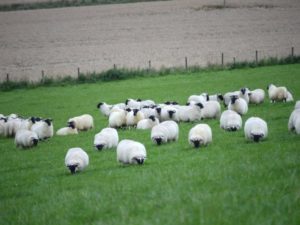Functional Sheep – Lower Costs, Better Value
20 August 2016 Tackling lamb production costs using genetics to reduce labour starts with a move away from income directed traits that affect appearance. These include thicker and shorter leg bones, wider shoulder settings with deeper briskets and wider heads. Extremes of conformation contribute to a slower lambing and higher lamb losses, adding to labour costs. Try looking at historical pictures of breeds to see how far we have deviated, the Texel breed for example was initially imported as a maternal breed but is now very much a terminal sire breed.
Tackling lamb production costs using genetics to reduce labour starts with a move away from income directed traits that affect appearance. These include thicker and shorter leg bones, wider shoulder settings with deeper briskets and wider heads. Extremes of conformation contribute to a slower lambing and higher lamb losses, adding to labour costs. Try looking at historical pictures of breeds to see how far we have deviated, the Texel breed for example was initially imported as a maternal breed but is now very much a terminal sire breed.
To achieve carcass quality it is more relevant if you want to produce lamb cheaply to measure growth and meat yield, using ultrasonics or CT scanning.
Some breeds lamb easily like the Shetland, but are too small for the market. However there is large variation to select within breeds for a roomy pelvis that results in easy birth, even for singles. Broad heads and thick legs are an anathema, particularly for ewe lambs. Overweight lambs at birth, particularly with deep brisket depth which is incompressible, create problems.
SRUC research showed lamb vigour at birth was essential to bonding and lamb survival. This is a trait in itself but if the lamb has had an uncomfortable journey into the world it will be exhausted. It is possible more vigorous lambs will have less malpresentations.
If you expect a ewe to do well on pasture then it needs gut capacity to process large quantities. This helps when swards are of low digestibility so rumen volume is important – even if it is responsible for the lower killing out percentage in hill sheep.
When we trialled all grass wintering we were worried crosses out of terminal sire breeds would not cope but they did, probably because we restricted the feed so gut capacity was not limiting. Terminal sires and crosses do poorly as they do not have the gut capacity. In comparison with low digestibility roughages on hills. So its horses for courses.
Hill sheep need good mobility. The shoulder structure needs to direct weight straight down not with splayed legs. This is also important for any rotationally grazed sheep that must not tire under competitive grazing situations. Feet also contribute to mobility and those susceptible to foot rot should be culled from the gene pool.
John Vipond
Sign up to the FAS newsletter
Receive updates on news, events and publications from Scotland’s Farm Advisory Service
